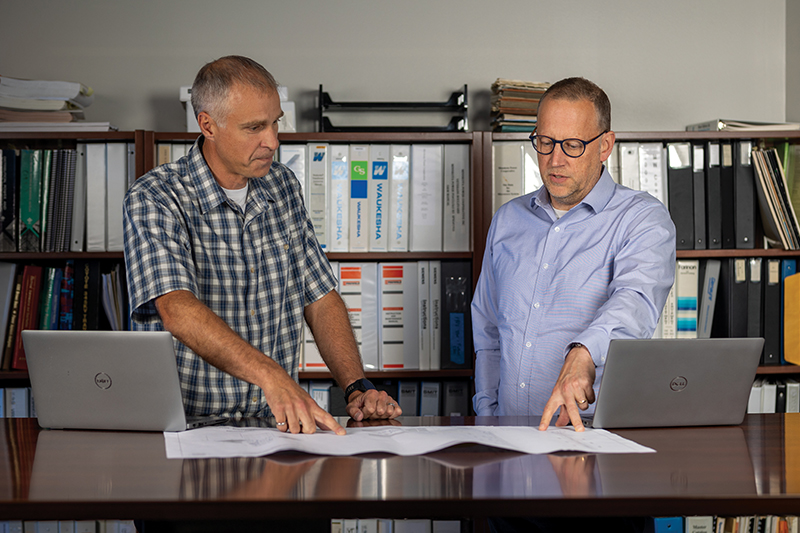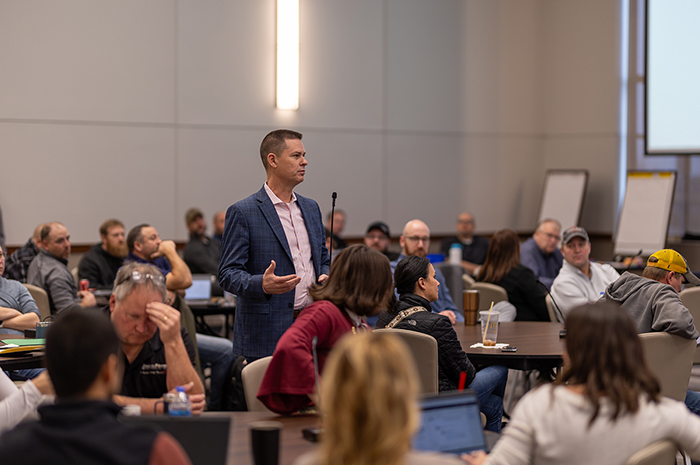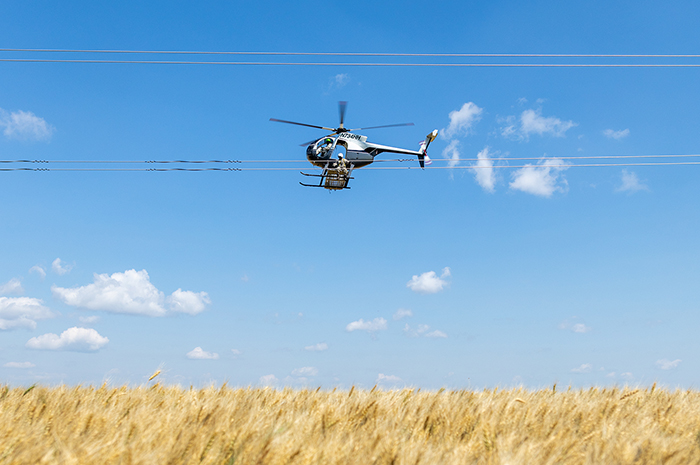From adversity to action
Behind the scenes of the June 20 storm response, Minnkota employees stepped up to answer the call.
As the final hours of June 20 ticked away, alarms lit up Minnkota’s Energy Control Center like warning flares in the night. Outside, lightning streaked across the sky. Inside, the system’s massive digital board, which offers a live view of the regional power grid, flashed with signs of chaos.
The nerve center of Minnkota’s power delivery system was under siege. “We just started losing lines all over the place,” said Reed Daws, system operations superintendent. “It’s some of the worst lightning we’ve ever seen. It was intense, and it just kept rolling east. We had lines down from Mandan (North Dakota) to Bemidji (Minnesota). It was 300 miles of pure damage.”
For Jeremy Wiegandt, it was his first major storm since becoming a power system operator in the Control Center two years earlier. As conditions worsened, he called in fellow operator Terry Peoples to provide support, while Daws and others joined to help with the massive undertaking. Together, they faced a barrage of phone calls, alerts and escalating outages.
“It was really stressful at first,” Wiegandt said. “But once the storm started rolling in, the mindset totally changes. You just lock in and do what needs to be done.”
From their stations at the Control Center, power system operators keep a watchful eye on the electric grid. With just a few commands, they can energize, de-energize or reroute power across the system. But during this event, the scope of the damage wasn’t fully understood until line crews reached the scene and navigated pitch-black conditions and unpredictable hazards.
Cell service was spotty, making real-time communication difficult. Still, coordination between operators and crews remained critical. With new challenges surfacing by the minute, even routine tasks demanded extra focus and care.
Above all, safety came first for the crews in the field and the public. Working together, operators and field personnel cleared debris from roads, secured downed lines and even removed damaged poles from a hospital parking lot.
Peoples compared the teamwork to a fast-paced basketball game.
“You’re in the game, but you’re not alone,” he said. “You’re passing the ball back and forth – it’s all about working together to get the job done safely and quickly.”
The next day, the ball was passed to operators Tanner Stegman and Kevin Kennelly, who carried the restoration work forward.
“The communication was strong,” Wiegandt said. “When I came back the next night, the day shift had already made a lot of progress. Clearances were written up and ready to go; it was impressive. We’ve got a great team.”
Supply chain initiative pays off
While power system operators managed the real-time storm response, Minnkota’s warehouse and procurement teams ran their own race against the clock.
At 1:30 a.m., Nick Bushaw’s phone rang. He grabbed a quick breakfast bar and headed straight to the warehouse, unsure of what he’d be walking into. It didn’t take long to find out.
As repair orders began flooding in, Bushaw, a warehouse worker, began pulling, packing and loading the critical materials crews would need to begin restoring power.
“I was actually pretty excited to get the call,” he said. “Every nut and bolt, all the way up to a transformer, comes through us in the warehouse. It’s our chance to help.”

Throughout the early morning, Bushaw hustled to stay ahead of crew requests, making sure no one was delayed waiting on parts. Quick-reference documents from Engineering helped him match the right materials to the right job.
“Even though I was alone, I didn’t feel alone,” Bushaw said. “The procurement team was always reaching out to see if I needed anything. I'm just proud of our team and the people who work with me. They're all hard workers and good people to deal with.”
In the office, Procurement Manager Scott Schreiner ran lunch over to Bushaw while coordinating materials, contractors and equipment on the fly.
That scramble was made far smoother thanks to a 2024 initiative in Minnkota’s annual Business Plan aimed at improving the cooperative’s supply chain readiness. A comprehensive overhaul of the inventory system and the addition of materials ensured that most critical components were already in stock and ready to deploy.
Still, Schreiner said, the most powerful resource in a crisis is relationships.
“When I opened my computer, I already had messages from suppliers offering help,” he said. “They knew we had storms and were ready to support us. They’re in the industry and know the expectations and responsibilities we have as a power supplier.”
The first urgent request was for truckloads of rock – necessary for setting and stabilizing dozens of new 69-kilovolt poles. Soon after, Schreiner’s team was securing a helicopter to conduct aerial assessments. Those views gave engineers a much-needed edge in identifying and prioritizing problem areas across the storm-ravaged region.
Engineering the comeback
With miles of lines down and assessments coming in, Minnkota’s engineers were already working on the recovery. Engineering Manager Wayne Lembke and his team gathered in the office over the weekend, mapping out the restoration plan and determining how to best utilize the materials available on-site.
“Engineering’s role starts long before the storm ever happens,” Lembke explained. “We’ve already assessed our system. We know what we have out there. We have our project records updated, we've gone through our storm stock and recently completed a big upgrade to that to make sure we have material here and ready to go.”

When the storm hits, those preparations enabled the team to shift from planning to execution.
“There’s always going to be that portion that we just can't respond to with on-hand material,” Lembke said. “But this storm proved that we had a lot of the materials we needed and had a good plan to respond.”
With so many moving parts, Minnkota’s Project Management Office (PMO) played a vital role in keeping every business unit aligned. The group meticulously tracked each project, which is essential not only for guiding ongoing work but also for meeting potential federal requirements if disaster assistance becomes available.
“Anytime an emergency situation happens, we immediately think of FEMA,” said Wade Horner, portfolio/project manager. “With that likelihood, we know there are requirements that will need to be fulfilled, so we try to get ahead of things as much as possible. Immediately, work orders were needed so material can be defined and tracked toward each respective project.”
The effort required close teamwork at every level. PMO worked hand in hand with crews, engineering and other support staff, ensuring that critical information flowed quickly.
“In PMO, we’re really a conduit for communication,” Horner said. “We consider many of the business units at Minnkota to be part of our team. Everyone understands the needs of our members and, simply enough, want to get the lights back on as soon as they can.”
MAIN IMAGE: (Left to right) Power system operators Jeremy Wiegandt, Tanner Stegman and Terry Peoples monitor the electric grid inside Minnkota’s Energy Control Center. The trio played a key role in responding to the June 20 storm outages. (Michael Hoeft/Minnkota)
...



